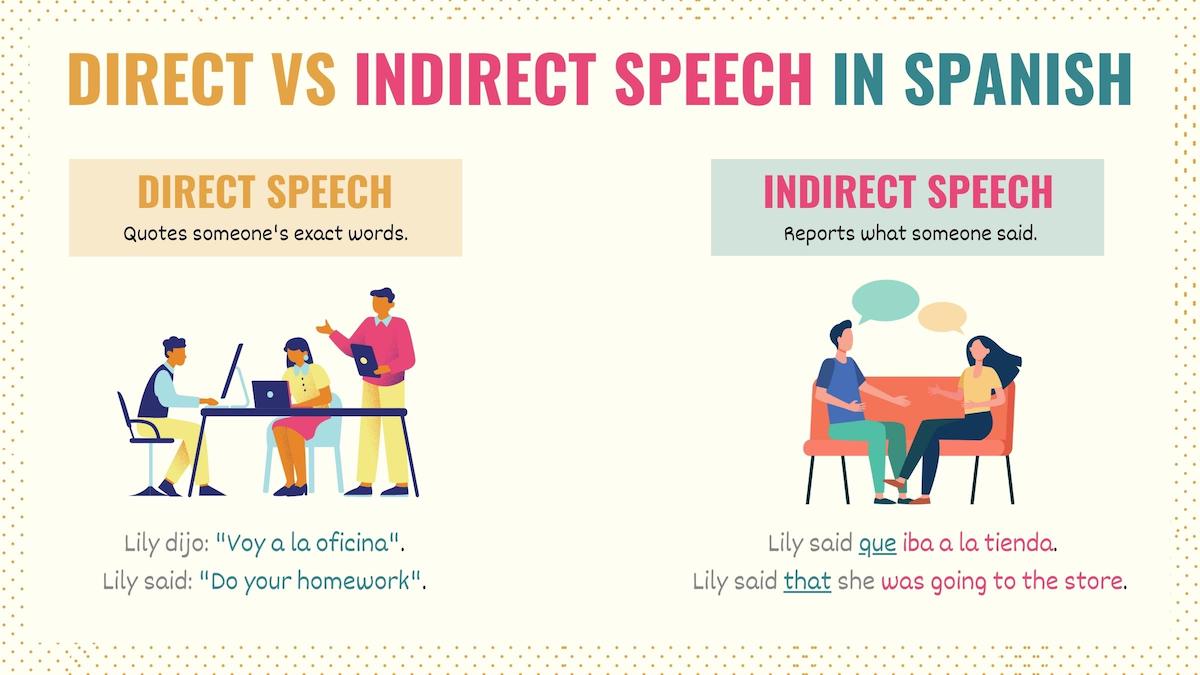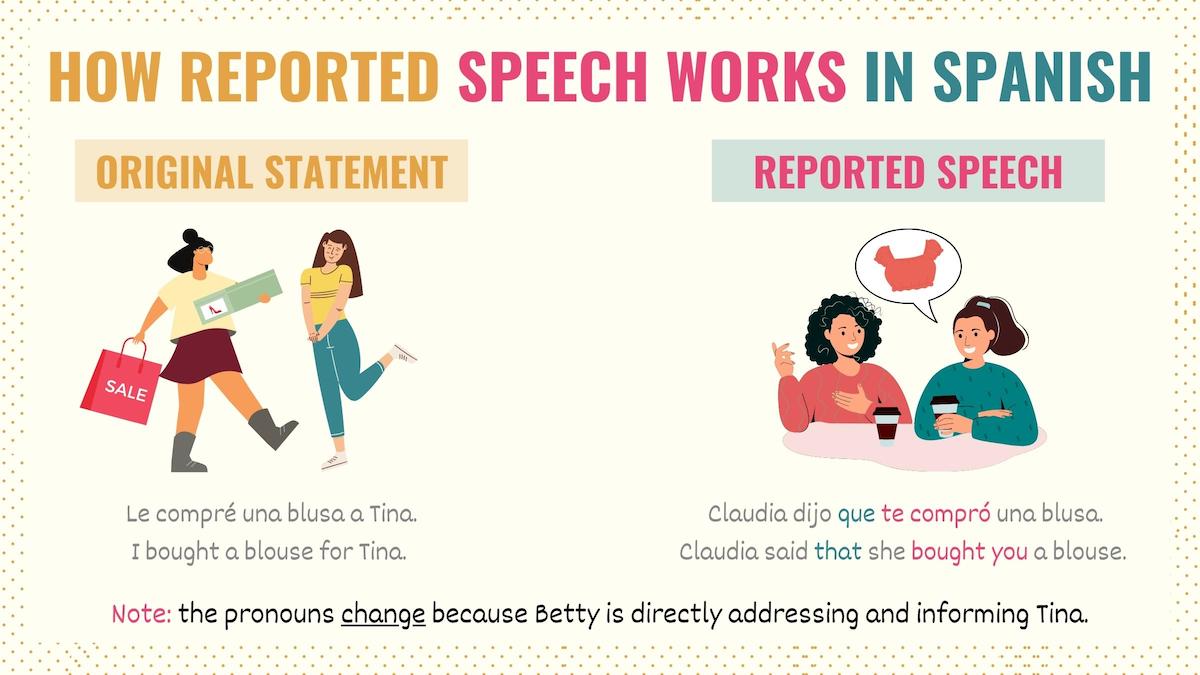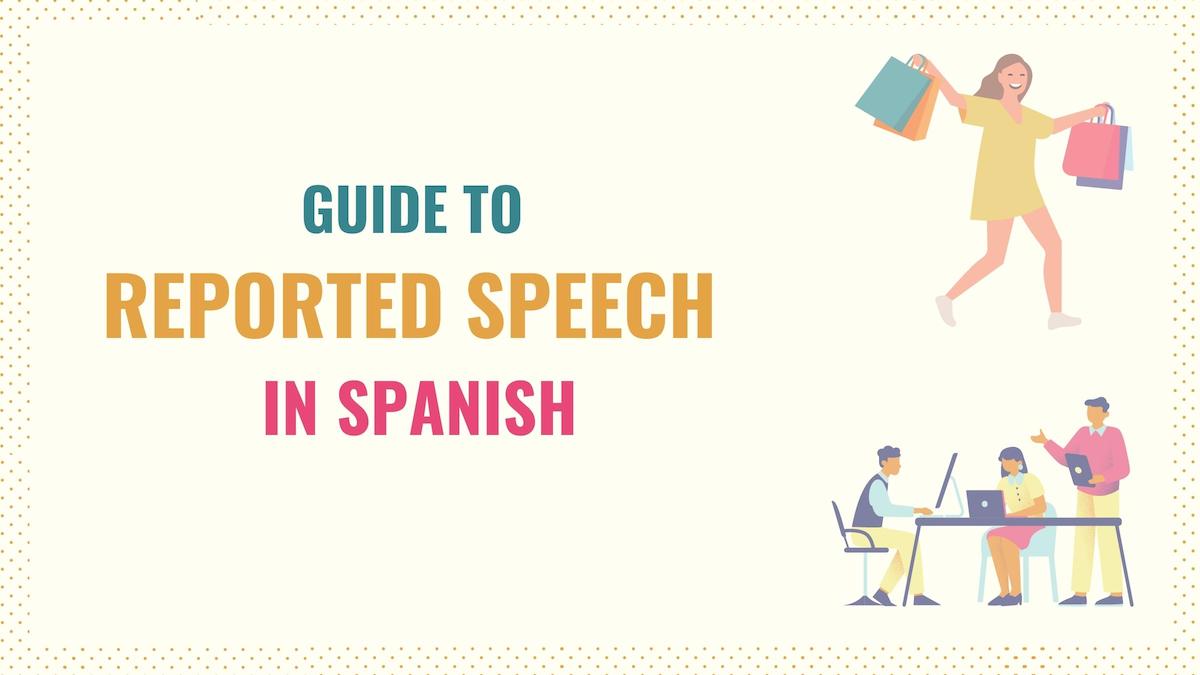Reported speech is an overlooked yet crucial feature in everyday conversations. In short, it allows you to convey what someone else said adequately. Since mastering this topic can boost your fluency, in this reported speech Spanish guide, you’ll learn:
In addition to this, I’ve also included different examples of how to apply this concept in real-life situations. Let’s do this!
What Is the Reported Speech in Spanish?
Reported speech in Spanish, also known as indirect speech, conveys what someone else said without quoting their exact words.

Simply put, Spanish indirect speech allows you to rephrase and report what someone said. On the contrary, direct speech involves quoting the exact words a person used. For instance:
| Direct speech sentence | Indirect speech sentence |
|---|---|
| Alba dijo: “Lava y dobla la ropa” Alba said, “Wash and fold the clothes” | Alba dijo que lavaras y doblaras la ropa. Alba said to wash and fold the clothes. |
In Spanish, decir is the most common verb to form the reported speech. However, you can also use the following verbs:
- Aclarar: Clarify / Explain
- Afirmar: Affirm / Clair
- Anunciar: Announce
- Contar: Tell
- Explicar: Explain
- Pedir: Ask
- Preguntar: Ask
- Prometer: Promise
- Recordar: Remember
- Recomendar: Recommend
- Sugerir: Suggest
Spanish indirect speech allows you to share information and someone’s thoughts or opinions with different people. As a result, it’s commonly used in news and writing environments, but also in daily conversations.
How to form indirect speech
To report what someone said, we use one of the previous verbs followed by que:
[Verb] + que + [statement]
| Direct speech | Indirect speech |
|---|---|
| Dile a Marco que abra las ventanas. Tell Marco to open the windows. | Mi mamá dijo que abrieras las ventanas. Mom said that you should open the windows. |
| Chicos, no podré ir. Guys, I will not be able to go. | Rubén nos dijo que no podría ir. Ruben told us that he couldn’t come. |
| Le sugiero que haga más ejercicio. I suggest you exercise more. | El doctor le sugirió que hiciera más ejercicio. The doctor suggested that she exercise more. |
When using reported speech in Spanish you’re repeating what another person said, we must do some modifications to preserve the meaning of the original sentence. These changes include:
- Adjust the pronouns and adjectives
- Change the verb tense (if applicable)
Take this graphic as an example:

Spanish Reported Speech: Verb Backshifting
When it comes to reported speech, verb conjugations are one of the major adjustments you must make. In simple words, we must change the tense of the original verb to maintain a logical sequence. In Spanish grammar, this is known as backshifting.
To help you understand and apply backshifting in reported speech, I’ve prepared this table that compares the original tenses with their backshifted equivalents:
| Original Tense | Backshifted | Direct S. Example | Reported S. Example |
|---|---|---|---|
| Present indicative | Imperfect tense | “No puedo ir” | Dijo que podía venir. |
| Preterite | Past perfect | “Ya compró todo” | Dijo que ya habías comprado todo. |
| Present perfect | Past perfect | “No he comido nada” | Dijo que no había comido nada. |
| Future simple | Conditional | “Llegaré a las 2” | Dijo que llegaría a las 2. |
| Imperative | Present subjunctive | “Cierra la puerta” | Dijo que cierres la puerta. |
| Present subjunctive | Imperfect subjunctive | “Quiero que venga” | Dijo que quería que vinieras. |
We only change the tense of a verb when the original action already took place. Let me break this down for you.
Let’s say you’re traveling and you call me today to tell me when you arrive. You’ll say:
Llegaré a las dos.
I will arrive at two.
But the time comes, and you’re not here. Everybody is asking me what time you’re supposed to arrive and I repeat what you said:
Me dijo que llegaría a las 2.
He said he would arrive at 2.
In this case, I backshifted the verb because the original action (arrival time) had already passed. The same happens with other tenses.
However, the tense of the original statement doesn’t change when talking about facts or when the action is still relevant (it just happened).
Take this sentence as an example:
| Original statement | Reported speech |
|---|---|
| No puedo ir porque estoy ocupada. I can’t go because I’m busy. | Dice que no puede ir porque está ocupada. She says she can’t go because she’s busy. |
This example implies that I’m immediately telling you what our friend said.
Reported Speech: Additional Spanish Resources
Transforming from direct and indirect speech requires knowledge of diverse grammatical elements. For starters, you must have a good command of Spanish pronouns so you know which pronoun to use for your sentence.
On that same note, you should also get familiar with possessive adjectives in case you need to mention someone’s belongings. And, of course, you must be comfortable conjugating verbs in different Spanish tenses.
Make sure you know how to form the:
- Present indicative
- Present perfect
- Present subjunctive
- Preterite tense
- Imperfect
- Imperfect subjunctive
- Past perfect
- Imperative
- Future simple
- Conditional tense
Download the Spanish Reported Speech PDF
Download a free PDF made for this guide including the graphics for reported speech as well as the backshifting verbs table so you can learn how to convert direct into indirect speech.



